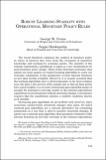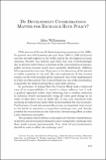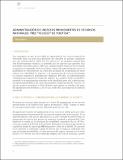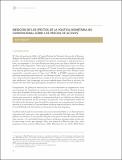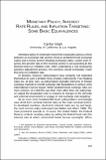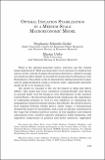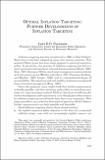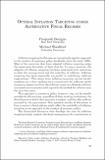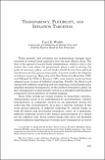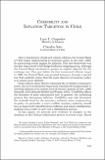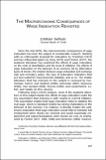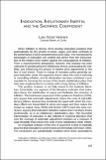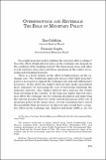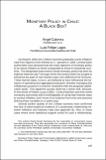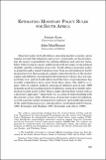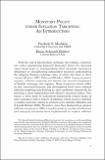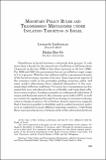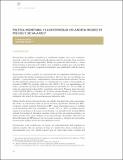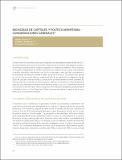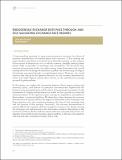Buscar
Mostrando ítems 601-620 de 645
Robust learning stability with operational monetary policy rules
The recent literature examines the conduct of monetary policy in terms of interest rate rules from the viewpoint of imperfect knowledge and learning by economic agents. The stability of the rational expectations equilibrium is taken as a key desideratum for good monetary policy design. Most of this ...
Do development considerations matter for exchange rate policy?
Chile was one of the world’s fastest-growing economies in the 1990s. Its growth rate of 6.8 percent per year from 1990 to 2000 (inclusive) was the seventh highest in the world, and by far the highest in Latin America. Poverty was halved, and while this was overwhelmingly due to growth rather than a ...
Administración de ingresos provenientes de recursos naturales: tres 'relojes' de política
Los ingresos provenientes de un recurso no renovable como el cobre plantean dos retos distintivos para las reglas de política económica. Los ingresos fluctúan porque los precios de las materias primas han sido históricamente volátiles y son generados por las rentas de un recurso no renovable que puede ...
Medición de los efectos de la política monetaria no convencional sobre los precios de activos
Una versión adaptada de los métodos de Gürkaynak, Sack y Swanson (2005) se utiliza aquí para estimar dos dimensiones de política monetaria durante el período de piso cero de la tasa de interés en Estados Unidos entre el 2009 y el 2015. Se muestra que, tras una rotación adecuada, estas dos dimensiones ...
Monetary policy, interest rate rules, and inflation targeting: some basic equivalences
Monetary policy in small open economies is typically cast as a choice between an exchange rate anchor (fixed or predetermined exchange rates) and a money anchor (floating exchange rates). Under such regimes, the growth rate of the nominal anchor is set according to the desired long-run inflation rate. ...
Optimal inflation stabilization in a medium-scale macroeconomic model
What is the optimal monetary policy, and how can the central bank implement it? Both questions have been extensively studied, but always in the context of simple theoretical structures, which by design are limited in their ability to account for actual observed business cycle fluctuations. This article ...
Optimal inflation targeting: further developments of inflation targeting
Inflation targeting was first introduced in 1990, in New Zealand. Since then it has been adopted by more than twenty countries. This period of fifteen years has seen major progress in practical monetary policy. In particular, the practice of inflation targeting has led to a more systematic and consistent ...
Optimal inflation targeting under alternative fiscal regimes
Inflation targeting has become an increasingly popular approach to the conduct of monetary policy worldwide since the early 1990s. Most of the countries that have adopted inflation targeting judge the experiment favorably, at least thus far. In many countries, the adoption of inflation targeting has ...
Transparency, flexibility, and inflation targeting
Three parallel and certainly not independent changes have occurred in central bank practices over the past fifteen years. The first is the spread of central bank independence, which is tied to the notion that even when the government plays a role in setting the goals of monetary policy, central banks ...
Credibility and inflation targeting in Chile
After a long history of high and volatile inflation, the Central Bank of Chile began implementing its monetary policy in the early 1990s by announcing yearly targets for inflation. This new framework was the first step toward a full-fledged inflation-targeting setup, although the Central Bank continued ...
The macroeconomic conseguences of wage indexation revisited
Since the mid-1970s, the macroeconomic consequences of wage indexation has been the subject of considerable research. Starting with an enthusiastic proposal for indexation by Friedman (1974) and two influential papers by Gray (1976) and Fischer (1977), the academic literature has examined the effects ...
Indexation, inflationary inertia, and the sacrifice coeficient
When inflation is chronic, firms develop indexation practices that automatically tie the growth of prices, wages, and other contracts to the performance of some comprehensive price index. The microeconomic advantages of indexation are evident and derive from the immunization of the relative price ...
Overshootings and reversals: the role of monetary policy
Does tight monetary policy stabilize the currency after a collapse?. Does the effect of high interest rates on the exchange rate depend on the condition of the banking system? The East Asian crises and other recent currency crises have put these questions at the center of economic policymaking decisions.
Monetary policy in Chile: a black box?
During the 1990s the Chilean economy gradually cut its inflation rate from figures in the thirties to 4.7 percent in 1998. Central bank authorities have declared that the main objective of monetary policy is to reduce inflation to levels comparableto those in industrial countries. The desgnated ...
Estimating monetary policy rules for South Africa
Monetary policy in South Africa's emerging market economy, given capital account liberalization and severe constraints on fiscal policy, has the major responsability for curbing inflation and currency instability while trying to ensure sufficient growth for longer-term political stability and the ...
Monetary policy under inflation targeting: an introduction
With the end of intermediate exchange rate regimes, countries are either abandoning domestic monetary policy (by choosing super-hard pegs or relinquishing their national currencies altogether) or strengthening independent monetary policymaking (by adopting floating exchange rates, of either the clean ...
Monetary policy rules and transmission mechanisms under inflation targeting in Israel
Disinflation in Israel has been a relatively slow process. It took more than a decade for the annual rate of inflation to fall from about 18 percent in the late 1980s to less than 4 percent in the late 1990s. For 2000 and 2001 the government has set an inflation target range of 3 to percent. Whether ...
Política monetaria y la enfermedad holandesa: rigidez de precios y de salarios
Mediante un modelo de economía pequeña y abierta, especializada en la producción de materias primas y que exhibe fricciones exógenas en la fijación de precios y salarios, estudiamos la respuesta óptima de la política monetaria y cambiaria tras un shock positivo (negativo) en el precio del producto ...
Movilidad de capitales y política monetaria: consideraciones generales
Este artículo es una mirada a la conferencia XV del Banco Central de Chile 'Movilidad de Capitales y Política Monetaria'. En su conjunto, los estudios presentados en ella tratan diversos aspectos de las causas, consecuencias y desafíos de política, relacionados con los ciclos de auge y caída que han ...
Endogenous exchange-rate pass-through and self-validating exchange rate regimes
Un dilema de larga data en las economías abiertas se refiere a la moneda en que se denominan los precios nominales y los contratos. Este trabajo analiza la interacción entre los precios de exportación de las empresas y la política monetaria, y sus posibles implicancias macroeconómicas en la sincronización ...

